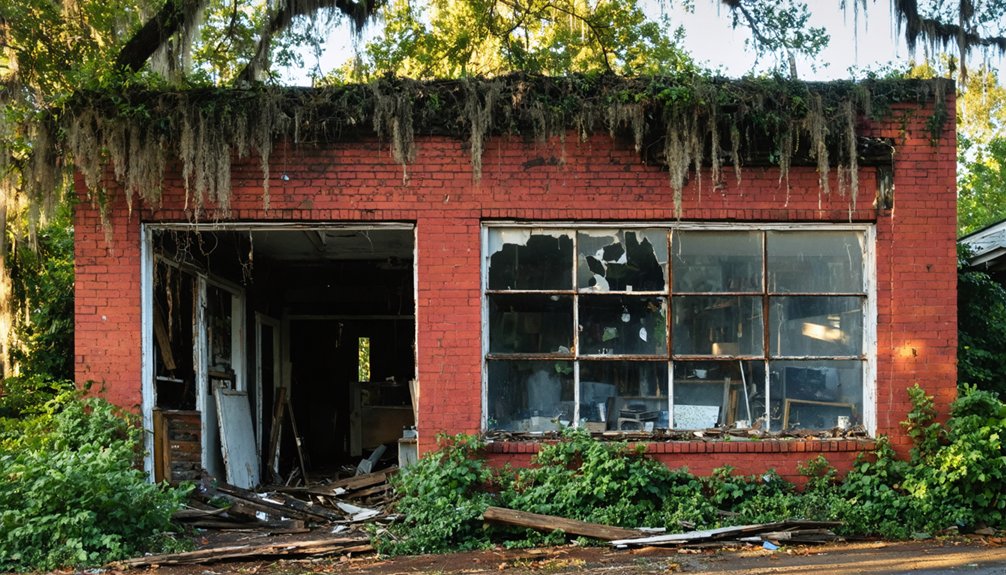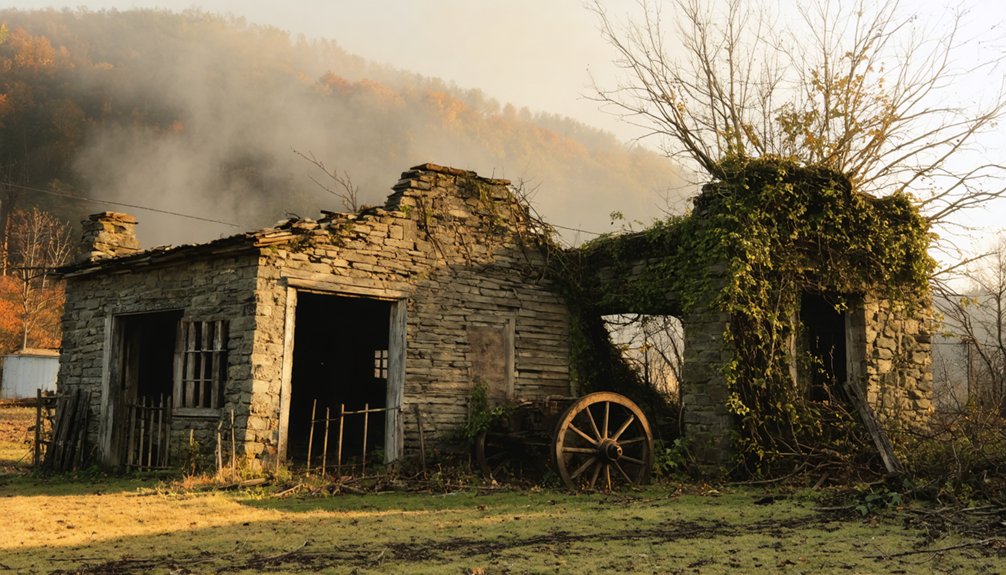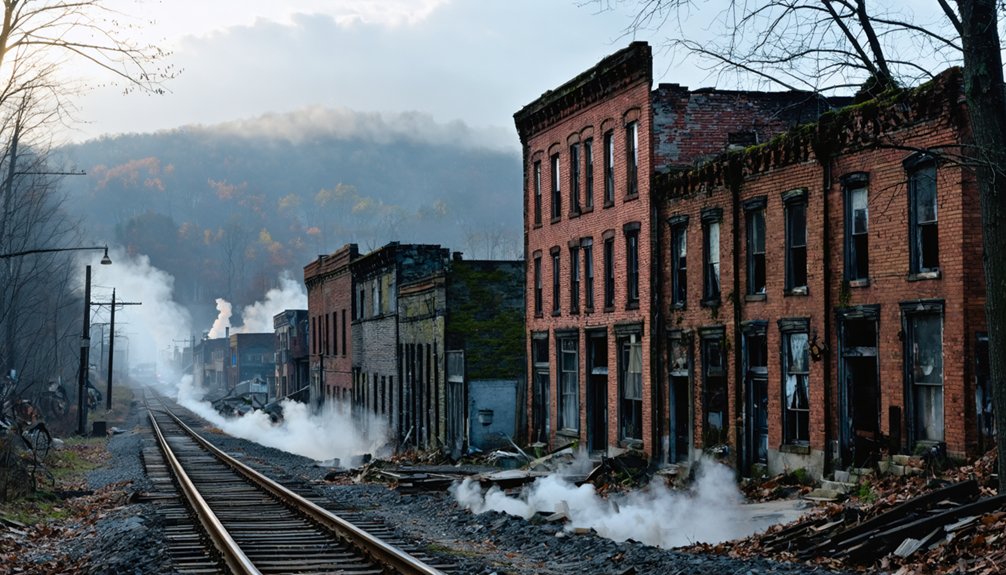America’s Civil War era ghost towns offer haunting glimpses into our nation’s most turbulent period. You’ll discover Cahaba, Alabama’s submerged first state capital, and Bannack, Montana, where Sheriff Plummer’s spirit still protests his vigilante execution. Fort Jefferson’s massive brick prison harbors echoes of Lincoln assassination conspirators, while Virginia City’s abandoned gold mines conceal stories of desperate miners and deadly gunfights. These preserved ruins await with their architectural marvels and spectral residents from a divided America.
Key Takeaways
- Cahaba, Alabama—once the state’s capital—served as a Civil War prison camp and features haunting ruins with reports of wandering soldiers’ spirits.
- Bannack, Montana contains over 60 preserved 1860s buildings and the infamous gallows where Sheriff Plummer was executed by vigilantes during the Civil War era.
- Virginia City experienced Civil War tensions between Southern sympathizers and Union troops, with dangerous mine tunnels where workers perished.
- Southern ghost towns like Blakeley and Claiborne bear witness to significant Civil War battles and preserve stories of suffering and conflict.
- Civil War prison camp sites like Andersonville saw thousands perish from disease and starvation, creating locations heavy with historical trauma.
Cahaba, Alabama: The Submerged Capital’s Spectral Remains

Where the waters of the Alabama and Cahaba rivers converge lies the haunting remnants of Cahaba, Alabama’s first state capital that rose to prominence in 1819 only to vanish beneath floodwaters and history’s tide.
Where rivers meet, the ghost town of Cahaba whispers secrets of Alabama’s first capital, now claimed by water and time.
You’re walking through submerged history when you visit this site, built atop an earlier Native American settlement possibly destroyed by de Soto in 1540.
By 1860, it flourished as a wealthy river town with 2,000 residents, mostly enslaved African Americans. During the Civil War, Cahaba’s cotton warehouse became Castle Morgan, imprisoning thousands of Union soldiers.
The town featured a carefully planned grid layout with streets named after trees, reminiscent of Philadelphia’s urban design.
The catastrophic 1865 flood preceded the Sultana disaster, America’s deadliest maritime tragedy that claimed nearly 2,000 released prisoners’ lives.
After the war, Cahaba ghosts lingered as freedmen transformed the abandoned town into a Reconstruction political center before its final abandonment. The historic site includes the preserved Crocheron mansion columns where Confederate General Forrest and Union General Wilson held their famous meeting.
Bannack, Montana: Where Outlaws and Their Victims Still Roam
When you visit Bannack’s frost-bitten remains, you’ll witness the abandoned infrastructure of Montana’s first territorial capital, where a gold discovery in 1862 triggered a population explosion to 5,000 residents within months.
You can stand beneath the same tree where Sheriff Henry Plummer—controversially accused of leading a murderous gang—was executed without trial by Montana Vigilantes in January 1864, part of a violent campaign that claimed 22 lives through extrajudicial hangings.
The gold found in the area was remarkably pure with 99-99.5% purity, making Grasshopper Creek especially attractive to miners and prospectors throughout the region.
The vigilantes’ infamous “3-7-77” warning symbol and their brutal brand of frontier justice continue to haunt this remarkably preserved ghost town, where defensive structures built against feared Native American attacks still stand alongside the Methodist church constructed as an act of thanksgiving for deliverance from those same threats.
Sidney Edgerton, a prominent Vigilante, became Montana’s first governor after the town was established as the territorial capital.
Gold Rush Gone Cold
Hidden along the Montana frontier, Bannack stands frozen in time as one of America’s most authentic Civil War-era ghost towns, where the echoes of its violent gold rush past still seem to linger in the weathered buildings.
When you walk these deserted streets, you’re treading where ghostly miners once chased fortune after the 1862 discovery. The town exploded to 10,000 residents—many Civil War deserters seeking freedom and opportunity—only to witness its abandoned dreams by the 1930s.
While nearby Virginia City ultimately overshadowed Bannack’s wealth, this settlement’s dramatic rise and fall perfectly captures the boom-bust cycle of Western expansion. Over 60 preserved buildings remain, maintained in their original 1860s condition for visitors to explore.
The railroad’s decision to bypass Bannack in the 1880s sealed its fate, leaving behind only memories of lawlessness, vigilante justice, and the prosperity that slipped through pioneers’ fingers like gold dust. The town briefly served as Montana Territory’s capital in 1864 before quickly losing this status as its influence waned.
Sheriff Plummer’s Hanging Tree
The gnarled branches of Bannack’s infamous hanging tree cast long shadows over Montana’s darkest chapter of frontier justice.
As you stand before this historic gallows, you’re witnessing where Sheriff Henry Plummer met his fate on January 10, 1864. Vigilante justice claimed him without trial, along with deputies Buck Stinson and Ned Ray that same night.
The hanging tree legends persist—many believe Plummer’s spirit still roams these grounds, protesting his innocence.
Ironically, he built the very gallows that ended his life. While vigilantes accused him of leading a murderous gang, historians debate his guilt to this day. A 1993 posthumous trial in Virginia City ended with a hung jury, suggesting reasonable doubt about his alleged crimes. Before the jail’s construction, Plummer convinced townsfolk to fund the facility through individual subscriptions, collecting as little as $2.50 from each resident.
Now preserved within Bannack State Park, this execution site attracts those seeking both historical understanding and paranormal encounters, embodying the lawless freedom and brutal consequences of America’s western frontier.
Vigilante Justice Echoes
Montana’s lawless frontier sparked America’s deadliest vigilante movement in Bannack during the bitter winter of 1863-64. As you walk through the preserved buildings today, you’re treading where masked men hunted down Sheriff Henry Plummer and his deputies, hanging them without trial on January 10, 1864.
The frontier justice was swift and merciless—22 alleged criminals executed in just two months. The vigilante repercussions transformed the town, with crime rates dropping as the “3-7-77” symbol (representing grave dimensions) struck fear into outlaws’ hearts.
The population plummeted from 10,000 to mere hundreds by the late 1860s.
Now preserved as a state park rather than restored, Bannack’s jail cells, gallows, and empty buildings stand as stark reminders of America’s violent vigilante past.
Fort Jefferson: A Military Prison’s Haunting Isolation
Deep in the crystalline waters of the Dry Tortugas, Fort Jefferson stands as a haunting monument to Civil War-era imprisonment and isolation.
As the Western Hemisphere’s largest masonry fort, its imposing brick walls once contained over 1,000 prisoners amid a backdrop of haunted isolation.
You’d find yourself trapped alongside deserters court-martialed by the Union, with escape virtually impossible from this remote island fortress.
By 1864, prisoners nearly outnumbered their guards, forced to labor under harsh tropical conditions while disease outbreaks claimed countless lives.
As prison ranks swelled beneath the merciless sun, men succumbed to fever’s grip while their labor built the very walls that confined them.
After Lincoln’s assassination, this site of military justice housed four conspirators, including Dr. Samuel Mudd, who attempted escape only to be thrown into the fort’s infamous “dungeon.”
The cracked cisterns, yellow fever outbreaks, and oppressive heat created conditions so severe that even today, the fort’s atmosphere feels weighted with suffering.
Constructed from 16 million bricks that were painstakingly handmade, the massive hexagonal structure became both an engineering marvel and a prison of no escape.
The devastating yellow fever epidemic of August 1867 decimated the fort’s population, taking the lives of many inhabitants including the prison doctor.
Virginia City: Gold Rush Ghosts of the Civil War Era
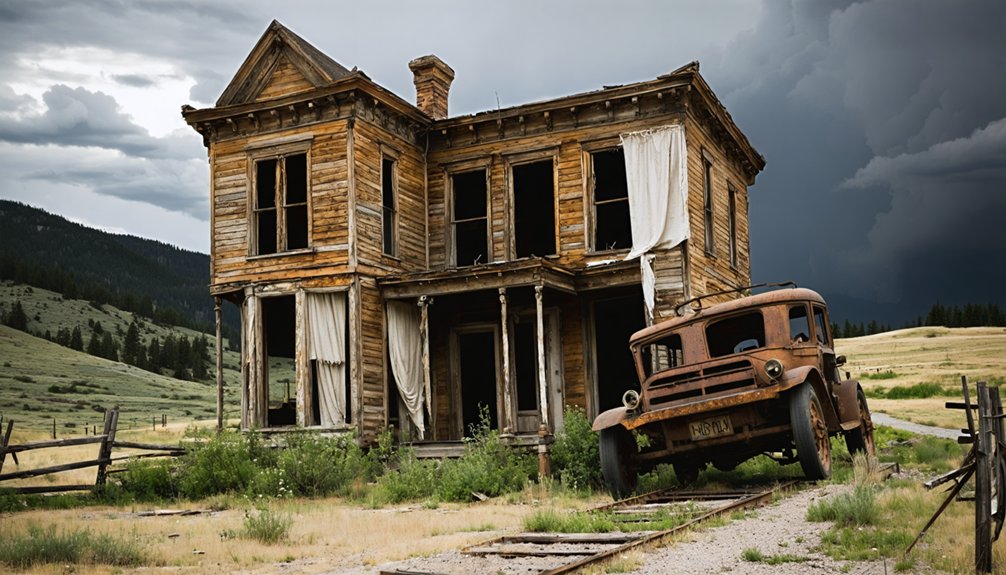
Amid the tumultuous backdrop of Civil War America, Virginia City emerged in 1859 following the discovery of the famed Comstock Lode—a silver deposit so immense it would eventually yield over $400 million and substantially finance Union war efforts.
Walking its wooden sidewalks today, you’re treading where Southern sympathizers once clashed with Union troops in a town built atop countless mining tragedies.
Four hallmarks of Virginia City’s haunted legacy:
- The Great Fire of 1875, which left 8,000 homeless and countless ghostly encounters
- The labyrinth of dangerous tunnels beneath the town where miners perished
- Union military occupation that led to violent confrontations with secessionists
- Mark Twain’s eyewitness accounts of deadly gunfights on the lawless streets
Batsto Village: From Revolutionary Iron to Postwar Hauntings
Walking through Batsto Village today, you’ll encounter remnants of its ironworks that once produced essential military supplies for Washington’s Continental Army during the Revolutionary War.
When iron production declined in the 1850s, the village shifted to glassmaking operations, though many workers reportedly never left—even after death—with visitors claiming to witness spectral glass blowers continuing their craft in abandoned workshops.
The village’s complex evolution through multiple owners—from Richards’ 92-year industrial dynasty to Wharton’s agricultural reinvention—created layered historical energies that paranormal investigators suggest contribute to Batsto’s reputation as one of New Jersey’s most actively haunted historic sites.
Iron Production Legacy
While most visitors today experience Batsto Village as a picturesque historic site, its foundations rest upon a formidable iron manufacturing legacy that proved essential to America’s independence. The ironworks history began when Charles Read established the facility in 1766, harnessing the region’s natural resources for industrial production.
Four critical elements defined Batsto’s industrial heritage:
- Continental Army exemptions for Batsto workers underscored their essential war contribution
- Production of military necessities including cannons, cannonballs, and camp kettles
- The Richards family’s 92-year stewardship modernizing operations through three generations
- Complete furnace rebuilding in 1829 that extended production capabilities
As you explore the remaining canal berms and loading slips along the Batsto River, you’re witnessing the physical remnants of America’s revolutionary manufacturing foundation.
Supernatural Glass Workers
After the decline of iron manufacturing in the late 19th century, Batsto Village experienced an economic renaissance through glass production that ironically spawned its most persistent supernatural legends.
When you visit today, you’ll find that tales of haunted craftsmanship permeate the preserved glassworks ruins. Spectral artisans are reportedly glimpsed shaping phantom molten glass, while eerie glowing lights and disembodied voices emanate from former furnace areas. These spirits, believed to be workers who perished during harsh industrial conditions, remain tethered to their craft.
The village’s isolation following its eventual abandonment only intensified its reputation for paranormal activity. Glass worker families once formed tight-knit communities in company housing, and their traditions live on through ghost stories.
Their skilled legacy continues through supernatural manifestations, making Batsto’s glassworkers eternally present in both history and spirit.
Civil War Prison Camps: Echoes of Suffering and Captivity

Among the darkest chapters of the Civil War era, prison camps stand as haunting monuments to human suffering and the brutal realities of 19th-century warfare.
These sites, where thousands perished from disease, starvation, and exposure, continue to echo with ghostly remnants of their tormented past.
The spectral echoes of wartime suffering linger in these haunted grounds, whispering forgotten histories of unimaginable torment.
When you visit these former prison camps today, you’ll encounter:
- Andersonville’s haunting grounds, where 13,000 Union soldiers died amid catastrophic overcrowding
- Point Lookout’s marshy terrain, where Confederate prisoners faced double the intended capacity
- Elmira’s “Hellmira” remnants, notorious for harsh winter conditions and inadequate shelter
- Camp Douglas’s eerie footprint, where prison camp suffering rivaled Andersonville’s brutal mortality rates
These sites transcend mere historical markers—they’re physical manifestations of wartime desperation, failed humanitarian efforts, and the lingering trauma etched into America’s landscape.
Mining Boomtowns: When Gold Fever Meets the Supernatural
The hastening years following America’s bloody Civil War witnessed a different kind of haunting in the western territories—one born not from battlefield deaths, but from gold fever and the relentless human pursuit of mineral wealth.
Places like Rhyolite, Tonopah, and Bodie transformed overnight from barren landscapes to bustling hubs with stamp mills, saloons, and thousands of fortune-seekers.
These boomtowns harbored their own dark mythology. Mining legends tell of spectral miners still working abandoned claims, their ghostly lanterns visible on moonless nights.
The environmental devastation left behind—mercury-poisoned streams and stripped mountainsides—mirrors the spiritual scars of these places.
With male-dominated populations and minimal law enforcement, violence and vigilante justice created tragic deaths that supposedly manifest as supernatural phenomena.
You’ll find these ghost towns frozen in time, evidence of America’s boom-and-bust mineral obsession.
Southern Ghost Towns: Civil War Scars and Plantation Phantoms
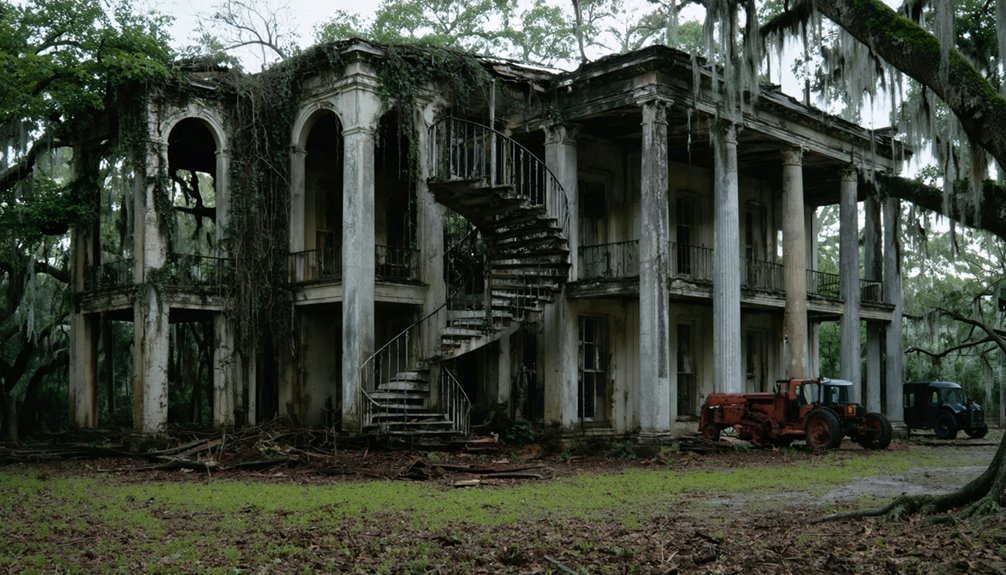
Deeply etched into the Southern landscape, Civil War ghost towns stand as silent testimonies to a region forever altered by the conflict that tore America apart.
Alabama’s abandoned settlements particularly reveal how war’s devastation and economic shifts transformed thriving communities into spectral memories.
- Cahawba, once Alabama’s proud capital, now harbors ruins of Castle Morgan where Confederate forces held Union prisoners amid the war’s chaos.
- Blakeley’s archaeological remains sit largely undisturbed, with local legends claiming Civil War ghosts still haunt the infamous “hanging tree.”
- Claiborne, once home to 5,000 residents, succumbed to disease and economic collapse, leaving only ghost legends and unmarked graves.
- St. Stephens’ scattered ruins bear witness to significant Civil War activity, with persistent tales of soldiers’ spirits wandering where battlefield tragedies unfolded.
Preserved in Time: Walking Through America’s Frozen Historic Ruins
Frozen in time like three-dimensional photographs, America’s preserved ghost towns offer visitors unparalleled glimpses into authentic daily life during pivotal historical periods.
You’ll find Bodie, California‘s arrested decay preserving 110 structures with belongings still inside homes, creating spectral landscapes that evoke the 1800s gold rush era.
In Centralia, Pennsylvania, you’ll witness the eerie consequences of an underground mine fire that’s burned since the 1960s, while Cahaba, Alabama‘s frozen architecture tells stories of its past as both state capital and Civil War prison camp.
At Fort Jefferson, Florida, you can explore America’s largest brick structure, abandoned after hurricane damage in 1906.
These ruins don’t just preserve history—they immerse you in tactile experiences of America’s tumultuous past.
Frequently Asked Questions
Are Any Civil War Ghost Towns Accessible for Paranormal Investigations?
You’ll find several accessible haunted locations including Bodie, Cahawba, Batsto Village, Virginia City, and Fort Jefferson, though most require following established paranormal tours rather than unrestricted investigations.
What Protective Measures Exist for Artifacts Found in Ghost Towns?
Like dusty sentinels guarding history, artifact preservation laws protect these treasures. You’ll find multiple layers of protection through ARPA, state historical regulations, strict museum conservation standards, and documentation requirements for discovered items.
Do Ghost Towns Show Evidence of Underground Railroad Activities?
You’ll find compelling historical evidence of Underground Railroad activities in certain ghost towns, particularly those with verified tunnels, hidden rooms, and documented way stations in northern states.
How Did Epidemic Diseases Contribute to Town Abandonments?
Like vultures circling weakened prey, epidemics devastated Civil War towns’ demographics. You’ll find disease impact evident where outbreaks decimated workforces, triggered economic collapse, and forced quarantines—ultimately compelling survivors to seek freedom elsewhere.
Can Visitors Experience Temperature Anomalies at Haunted Military Sites?
You’ll often encounter sudden temperature fluctuations at haunted military sites like Rosewell Ruins and Cornwallis’ Cave, where cold spots persist despite environmental conditions that should normalize thermal readings at these locations.
References
- https://www.loveexploring.com/gallerylist/131658/abandoned-in-the-usa-92-places-left-to-rot
- https://www.blueridgeoutdoors.com/go-outside/southern-ghost-towns/
- https://www.mentalfloss.com/geography/american-ghost-towns-can-still-walk-through
- https://www.wideopencountry.com/the-10-eeriest-ghost-towns-in-america/
- https://www.mythfolks.com/haunted-us-ghost-towns
- https://www.christywanders.com/2024/08/top-ghost-towns-for-history-buffs.html
- https://www.visittheusa.com/experience/5-us-ghost-towns-you-must-see
- https://www.geotab.com/ghost-towns/
- https://en.wikipedia.org/wiki/Lists_of_ghost_towns_in_the_United_States
- https://www.youtube.com/watch?v=RBVWYZjmjx8
